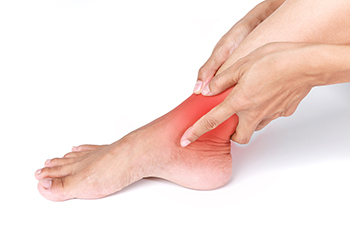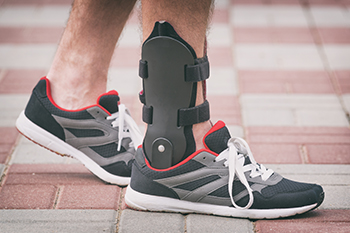Items filtered by date: May 2023
Simple Foot Stretches

Many people experience foot pain occasionally, or perhaps on a daily basis. It can occur for various reasons, including wearing shoes that do not fit correctly or from having an abnormal foot structure. Additionally, heel pain can be a common problem for patients, which can be indicative of a heel spur or plantar fasciitis. Stretching the heel can be done easily by standing on a step and lowering one heel at a time until a gentle stretch is felt. This may also be helpful in relieving arch pain. There are several muscles in the feet which move the toes, and stretching them may help to keep them flexible. The probability of developing hammertoe may decrease when the toes are frequently stretched. Performing these stretches can keep the toes from curling, which is the noticeable symptom in hammertoe. If you would like to learn about additional stretching techniques for the feet, it is suggested that you contact a podiatrist who can provide you with useful information.
Why Stretching Is Important for Your Feet
Stretching the feet is a great way to prevent injuries. If you have any concerns with your feet consult with Henrietta Obidigbo, DPM from Jersey Foot and Ankle Clinic. Our doctor will assess your condition and provide you with quality foot and ankle treatment.
Stretching the Feet
Stretching the muscles in the foot is an important part in any physical activity. Feet that are tight can lead to less flexibility and make you more prone to injury. One of the most common forms of foot pain, plantar fasciitis, can be stretched out to help ease the pain. Stretching can not only ease pain from plantar fasciitis but also prevent it as well. However, it is important to see a podiatrist first to determine if stretching is right for you. Podiatrists can also recommend other ways to stretch your feet. Once you know whether stretching is right for you, here are some excellent stretches you can do.
- Using a foam roller or any cylindrical object (a water bottle or soda can will do), roll the object under your foot back and forth. You should also exert pressure on the object. Be sure to do this to both feet for a minute. Do this exercise three times each.
- Similar to the previous exercise, take a ball, such as a tennis ball, and roll it under your foot while seated and exert pressure on it.
- Grab a resistance band or towel and take a seat. If you are using a towel, fold it length wise. Next put either one between the ball of your foot and heel and pull with both hands on each side towards you. Hold this for 15 seconds and then switch feet. Do this three times for each foot.
- Finally hold your big toe while crossing one leg over the other. Pull the toe towards you and hold for 15 seconds. Once again do this three times per foot.
It is best to go easy when first stretching your foot and work your way up. If your foot starts hurting, stop exercising to ice and rest the foot. It is advised that you then see a podiatrist for help.
If you have any questions, please feel free to contact our office located in Freehold, NJ . We offer the newest diagnostic and treatment technologies for all your foot care needs.
Simple Methods That Can Prevent Running Injuries

People who enjoy running and jogging are aware of how a running injury can interrupt this hobby. The importance of preventing running injuries ranks high among runners, and there are effective methods that can accomplish this. It is beneficial to stay hydrated by drinking plenty of water, which may help to prevent foot cramps. Stretching before and after running is effective in keeping the muscles limber, in addition to wearing running shoes that fit correctly. Many runners find it is better for their body to gradually change running surfaces, if desired, and to recover for an adequate amount of time. There are several types of running injuries, which may be prevented by taking care of the body. If you would like more information about how to do this, it is suggested that you consult with a podiatrist who can present you with effective tips on how to prevent running injuries.
Exercising your feet regularly with the proper foot wear is a great way to prevent injuries. If you have any concerns about your feet, contact Henrietta Obidigbo, DPM of Jersey Foot and Ankle Clinic. Our doctor will treat your foot and ankle needs.
How to Prevent Running Injuries
Many common running injuries are caused by overuse and overtraining. When the back of the kneecap starts wearing out and starts causing pain in your knee, this is commonly referred to as runner’s knee. Runner’s knee is a decrease in strength in your quadriceps and can occur if you’re not wearing properly fitted or supporting shoes. To prevent runner’s knee, focusing on hip strengthening is a good idea, as well as strengthening your quads to keep the kneecaps aligned.
What Are Some Causes of Running Injuries?
- One cause of a common running injury is called iliotibial band syndrome.
- Plantar fasciitis is also another common injury.
- Stress fractures can occur from overtraining, lack of calcium, or even your running style.
Best Ways to Prevent Running Injuries
- Wear footwear that fits properly and suits your running needs.
- Running shoes are the only protective gear that runners have to safeguard them from injury.
- Make a training schedule. Adding strengthening exercises as well as regular stretching can help keep you strong and limber and can lessen the possibility of injuries.
- Stretching keeps muscles limber; this will help you gain better flexibility.
If you have any questions please feel free to contact our office located in Freehold, NJ . We offer the newest diagnostic and treatment technologies for all your foot and ankle needs.
Ankle Pain and Rheumatoid Arthritis

Many people are currently living with a condition known as rheumatoid arthritis, or RA, which is an inflammatory disease that attacks the joints. Individuals who have or are developing rheumatoid arthritis often experience certain symptoms that are highly indicative of the condition. For example, the joints in the body may ache, and more specifically, the ankles may be affected. Sometimes, the aching and pain can be symmetrical in the ankles, which means that both of the ankle joints may ache. Importantly, those whose ankles are affected by rheumatoid arthritis may also experience some amount of swelling in the ankle joints. If you think that you have rheumatoid arthritis and your ankles are being affected, it is suggested that you contact a podiatrist today for an appointment.
Ankle pain can be caused by a number of problems and may be potentially serious. If you have ankle pain, consult with Henrietta Obidigbo, DPM from Jersey Foot and Ankle Clinic. Our doctor will assess your condition and provide you with quality foot and ankle treatment.
Ankle pain is any condition that causes pain in the ankle. Due to the fact that the ankle consists of tendons, muscles, bones, and ligaments, ankle pain can come from a number of different conditions.
Causes
The most common causes of ankle pain include:
- Types of arthritis (rheumatoid, osteoarthritis, and gout)
- Ankle sprains
- Broken ankles
- Achilles tendinitis
- Achilles tendon rupture
- Stress fractures
- Bursitis
- Tarsal tunnel syndrome
- Plantar fasciitis
Symptoms
Symptoms of ankle injury vary based upon the condition. Pain may include general pain and discomfort, swelling, aching, redness, bruising, burning or stabbing sensations, and/or loss of sensation.
Diagnosis
Due to the wide variety of potential causes of ankle pain, podiatrists will utilize a number of different methods to properly diagnose ankle pain. This can include asking for personal and family medical histories and of any recent injuries. Further diagnosis may include sensation tests, a physical examination, and potentially x-rays or other imaging tests.
Treatment
Just as the range of causes varies widely, so do treatments. Some more common treatments are rest, ice packs, keeping pressure off the foot, orthotics and braces, medication for inflammation and pain, and surgery.
If you have any questions, please feel free to contact our office located in Freehold, NJ . We offer the newest diagnostic and treatment technologies for all your foot care needs.
Benefits of Wearing an Ankle Brace

If you have injured an ankle, it may take a long time to heal. The goal is to help it heal completely in order to ward off future injuries to the same ankle. Many patients find that using an ankle brace can help. In fact, in many cases, wearing an ankle brace also helps to prevent an injury in the first place. A number of types of ankle braces are available, including those made with elastic materials that slip onto the foot and those made with more solid material and straps that encase the foot. A brace can help to reduce strain, tension, and pressure on the ankle joint. One of the major uses of an ankle brace is to immobilize the joint and help to reduce swelling after an injury. Among the many problems that can be helped by wearing an ankle brace are sprains, Achilles tendonitis, and arthritis. For help with choosing the correct type of ankle brace, it is suggested that you make an appointment with a podiatrist.
If you are having discomfort in your feet and would like to try orthotics, contact Henrietta Obidigbo, DPM from Jersey Foot and Ankle Clinic. Our doctor can provide the care you need to keep you pain-free and on your feet.
What Are Orthotics?
Orthotics are inserts you can place into your shoes to help with a variety of foot problems such as flat feet or foot pain. Orthotics provide relief and comfort for minor foot and heel pain but can’t correct serious biomechanical problems in your feet.
Over-the-Counter Inserts
Orthotics come in a wide variety of over-the-counter inserts that are used to treat foot pain, heel pain, and minor problems. For example, arch supports can be inserted into your shoes to help correct overarched or flat feet, while gel insoles are often used because they provide comfort and relief from foot and heel pain by alleviating pressure.
Prescription Orthotics
If over-the-counter inserts don’t work for you or if you have a more severe foot concern, it is possible to have your podiatrist prescribe custom orthotics. These high-quality inserts are designed to treat problems such as abnormal motion, plantar fasciitis, and severe forms of heel pain. They can even be used to help patients suffering from diabetes by treating foot ulcers and painful calluses and are usually molded to your feet individually, which allows them to provide full support and comfort.
If you are experiencing minor to severe foot or heel pain, it’s recommended to speak with your podiatrist about the possibilities of using orthotics. A podiatrist can determine which type of orthotic is right for you and allow you to take the first steps towards being pain-free.
If you have any questions please contact our office located in Freehold, NJ . We offer the newest diagnostic and treatment technologies for all your foot and ankle needs.
The Pros of Laser Treatment for Toenail Fungus

Toenail fungus is a common foot condition, and there is a remedy available that may benefit some patients. It is referred to as laser treatment, and it may be a promising option for this stubborn foot condition. It is done by using concentrated light that is aimed at the toenails which may help to eliminate the fungus, and prevent it from growing. Research has shown that the majority of patients will have little or no discomfort while getting this procedure done, and it is easily administered. There is generally no recovery time needed, and as the toenail grows, results may begin to be seen in approximately two months. There is a reduced risk of complications, which can make this treatment potentially safe for pregnant women and children to undergo. If you are interested in this type of treatment, it is suggested that you consult with a podiatrist who can help you to make a correct decision.
Laser treatment can be an effective way to get rid of toenail fungus. If you have any questions about laser treatment, consult with Henrietta Obidigbo, DPM from Jersey Foot and Ankle Clinic. Our doctor will assess your condition and provide you with quality treatment for fungal nails.
What Are Toenail Fungal Infections?
Onychomycosis, or fungal infection of the nail, is a relatively common and non-serious condition. Around 10 percent of U.S. citizens are afflicted with fungal nails. Common forms of fungus that infect the nail include dermatophytes, yeasts, and molds.
Symptoms of Toenail Fungal Infections Include:
- Nail thickening
- Brittleness of the nail
- Discoloration of the nail
Diagnosis for Fungal Nails
Fungal infections are diagnosed by fungal culture and microscopy. This will rule out any other conditions such as nail trauma, psoriasis, lichen planus, and onychogryphosis.
What Is Laser Treatment?
Laser treatment is a non-invasive, safe, quick, and painless procedure that uses the heat from a laser to kill fungus in the nail. Each infected nail is targeted with a laser for several minutes. The treatment is usually utilized several different times over a select period. During this time, a podiatrist will keep an eye on the infection.
If you have any questions, please feel free to contact our office located in Freehold, NJ . We offer the newest diagnostic and treatment technologies for all your foot care needs.




